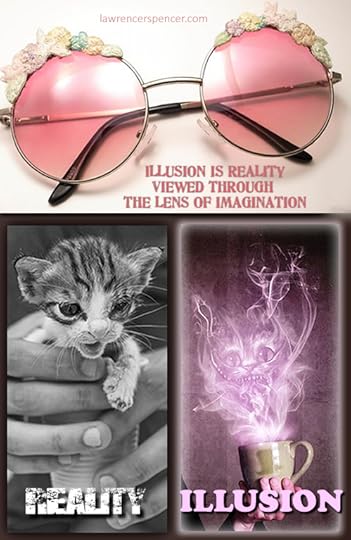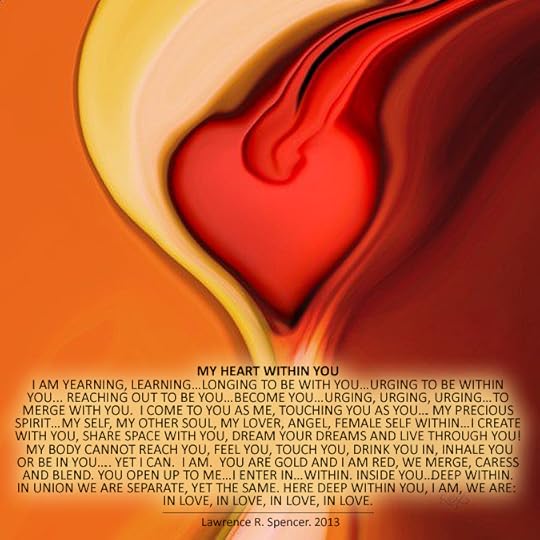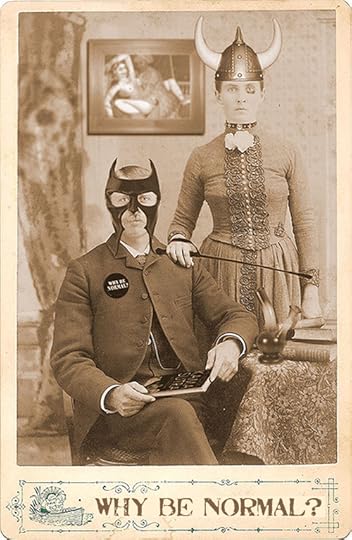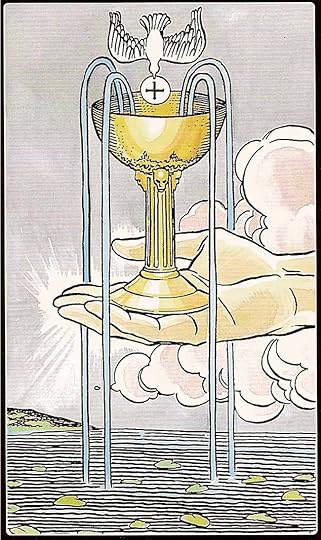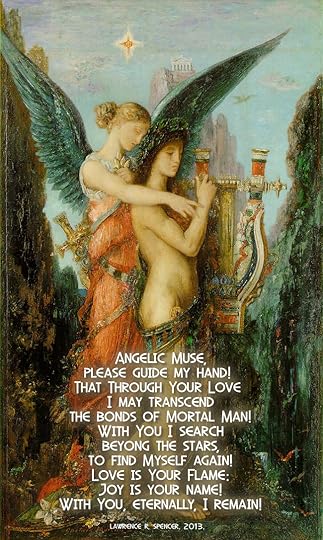Lawrence R. Spencer's Blog, page 566
March 6, 2013
HACKSCHOOLING
When 13 year-old Logan LaPlante grows up, he wants to be happy and healthy. He discusses how hacking his education is helping him achieve this goal.

REALITY vs ILLUSION
March 5, 2013
MY HEART WITHIN YOU
MY HEART WITHIN YOU
I AM YEARNING, LEARNING… LONGING TO BE WITH YOU… URGING TO BE WITHIN YOU... REACHING OUT TO BE YOU… BECOME YOU… URGING, URGING, URGING… TO MERGE WITH YOU. I COME TO YOU AS ME, TOUCHING YOU AS YOU…. MY PRECIOUS SPIRIT… MY SELF, MY OTHER SOUL, MY LOVER, ANGEL, FEMALE SELF WITHIN… I CREATE WITH YOU, SHARE SPACE WITH YOU, DREAM YOUR DREAMS AND LIVE THROUGH YOU! MY BODY CANNOT REACH YOU, FEEL YOU, TOUCH YOU, DRINK YOU IN, INHALE YOU OR BE IN YOU….. YET I CAN. I AM. YOU ARE GOLD AND I AM RED, WE MERGE, CARESS AND BLEND. YOU OPEN UP TO ME… I ENTER IN… WITHIN. INSIDE YOU…DEEP WITHIN. IN UNION WE ARE SEPARATE, YET THE SAME. HERE DEEP WITHIN YOU, I AM, WE ARE:
IN LOVE, IN LOVE, IN LOVE, IN LOVE.
_______________________________
Lawrence R. Spencer. 2013

March 4, 2013
NORMAL?
FLYING
Flying is done more easily and freely OUTSIDE of your body!!!  Pin It
Pin It
Nice Little Penguins
Flying
"Here I am, I'm on my own
for the first time really on my own
So will I make it will it work alright
can I make it through the night
And I go
ooh, ooh, ooh, ooh, I am flying
ooh, ooh, ooh, ooh, in open space
Look at me, I'm riding high
I'm the airborne master of the sky
And everything beneath me seems to fade
without a trace, without a shape
And I go
ooh, ooh, ooh, ooh, I am flying
ooh, ooh, ooh, ooh, in open space
And eveything beneath me seems to fade
without a trace, without a shape
And I go
ooh, ooh, ooh, ooh, I am flying
ooh, ooh, ooh, ooh, in open space
And I go
ooh, ooh, ooh, ooh, I am flying
ooh, ooh, ooh, ooh, in open space"

STOP BEING HUMAN!
March 2, 2013
ACE OF CUPS
Ace of Cups is a card used in Latin suited playing cards (Italian, Spanish and tarot decks). It is the Ace from the suit of Cups. In Tarot, it is part of what card readers call the "Minor Arcana", and as the first in the suit of Cups, signifies beginnings in the area of the social and emotional in life. Tarot cards are used throughout much of Europe to play tarot card games.
Playing cards first entered Europe in the late 14th century, probably from Mamluk Egypt, with suits very similar to the tarot suits of Swords, Staves, Cups and Coins (also known as disks, and pentacles) and those still used in traditional Italian, Spanish and Portuguese decks.
The first known documented tarot cards were created between 1430 and 1450 in Milan, Ferrara and Bologna in northern Italy when additional trump cards with allegorical illustrations were added to the common four-suit pack. These new decks were originally called carte da trionfi, triumph cards, and the additional cards known simply as trionfi, which became "trumps" in English. The first literary evidence of the existence of carte da trionfi is a written statement in the court records in Ferrara, in 1442. The oldest surviving tarot cards are from fifteen fragmented decks painted in the mid 15th century for the Visconti-Sforza family, the rulers of Milan.
The Ace of Cups shows a hand holding a cup or chalice that is overflowing with five streams of water. The hand that appears from the clouds represents our consciousness of spiritual energy and influence. Radiating from the hand are rays which symbolizes that you must always trust your inner feelings and your heart to lead the way. This is your intuition and inner power talking to you. The five streams represent the abundance and power of the spirit and the effect of spiritual energy upon our five senses. A dove holding a wafer or small disc in its mouth descends from above, signifying the incarnation and appearance of the spirit in the material world. Below the hand is a great sea covered with lotus blossoms, symbolizing the awakening of the human spirit.
The Ace of Cups Tarot card's meaning is of joy and inner peace from friends and family. The five streams pouring out of the cup represent the five senses: sight, smell, hearing, taste and touch. As a symbol of possibility in the area of deep feelings, intimacy, attunement, compassion and love, in divination, it shows that a seed of emotional awareness has been planted in your life although you may not yet recognize it. When the seed sprouts, it could take almost any form. It might be an attraction, strong feeling, intuitive knowing, or sympathetic reaction. On the outside, it could be an offer, gift, opportunity, encounter or synchronistic event.
This card also suggests inner spirituality. Cups are the suit of the heart, and the Ace stands for the direct knowing that comes from the heart. Trust what your feelings are telling you. Seek out ways to explore your consciousness and your connections with Spirit. Allow the power of your emotions to guide you in a new direction. Embrace the love that is the Ace of Cups.

March 1, 2013
MY MUSE
The Muses (Ancient Greek: Μοῦσαι, moũsai: perhaps from the o-grade of the Proto-Indo-European root *men- "think") in Greek mythology, poetry, and literature, are the goddesses of the inspiration of literature, science and the arts. They were considered the source of the knowledge, related orally for centuries in the ancient culture that was contained in poetic lyrics and myths.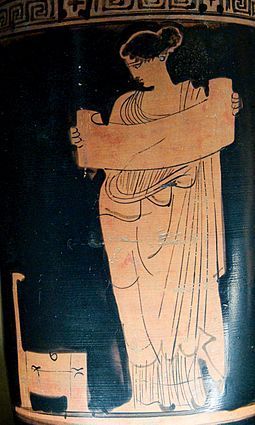 Pin It
Pin It
Greek mousa is a common noun as well as a type of goddess: it literally means "art" or "poetry". In Pindar, to "carry a mousa" is "to excel in the arts". The word probably derives from the Indo-European root men-, which is also the source of Greek Mnemosyne, English "mind", "mental" and "memory" and Sanskrit "mantra".
The Muses, therefore, were both the embodiments and sponsors of performed metrical speech: mousike (whence the English term "music") was just "one of the arts of the Muses". Others included Science, Geography, Mathematics, Philosophy, and especially Art, Drama, and inspiration.
( PHOTO: Ancient Greek vase showing a Muse reading a scroll, (Attic red-figure lekythos, Boeotia c. 435–425 BC) --->
Some authors invoke Muses when writing poetry, hymns, or epic history. The invocation typically occurs at or near the beginning, and calls for help or inspiration, or simply invites the Muse to sing through the author. Some prose authors also call on the aid of Muses, who are called as the true speaker for whom an author is merely a mouthpiece.
Shakespeare's Sonnet 38 invokes the Tenth Muse:
"How can my Muse want subject to invent,
While thou dost breathe, that pour'st into my verse
Thine own sweet argument?"
"No Muse-poet grows conscious of the Muse except by experience of a woman in whom the Goddess is to some degree resident; just as no Apollonian poet can perform his proper function unless he lives under a monarchy or a quasi-monarchy. A Muse-poet falls in love, absolutely, and his true love is for him the embodiment of the Muse... But the real, perpetually obsessed Muse-poet distinguishes between the Goddess as manifest in the supreme power, glory, wisdom, and love of woman, and the individual woman whom the Goddess may make her instrument... The Goddess abides."(comment by the British poet Robert Graves)

February 28, 2013
LIFE GOING PERFECTLY
It is possible to have Joy, and Love and Happiness and a Life going absolutely perfectly. Perhaps this is not true in the physical universe, but you can create a universe of YOUR OWN were there are no troubles, and life is going perfectly. It begins in your imagination, creating illusions, dreaming dreams and the decision that Your Illusions ARE Reality for You.



